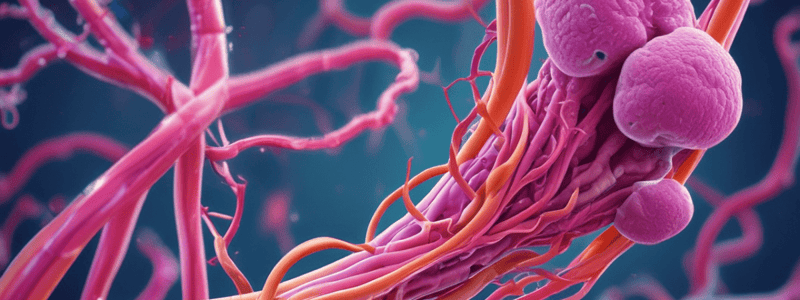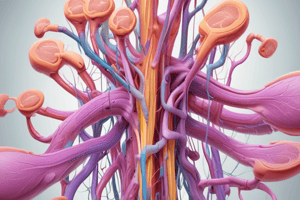Podcast
Questions and Answers
Which of the following is NOT a type of cast seen in the urine?
Which of the following is NOT a type of cast seen in the urine?
- Hyaline cast
- Renal artery stenosis cast (correct)
- Waxy cast
- Red blood cell cast
Which of the following conditions involves inflammation of the interstitium surrounding the nephrons?
Which of the following conditions involves inflammation of the interstitium surrounding the nephrons?
- Nephritic syndrome
- Horseshoe kidney
- Tubulointerstitial nephritis (correct)
- Acute tubular necrosis
What is the preferred term for acute kidney injury with morphologic evidence of tubular damage, but without necrosis?
What is the preferred term for acute kidney injury with morphologic evidence of tubular damage, but without necrosis?
- Acute tubular injury (correct)
- Renal artery stenosis
- Acute tubular necrosis
- Nephritic syndrome
Which of the following is a congenital abnormality of the kidneys?
Which of the following is a congenital abnormality of the kidneys?
Which of the following is a disorder characterized by inflammation of the glomeruli?
Which of the following is a disorder characterized by inflammation of the glomeruli?
What is the most common cause of acute kidney injury, according to the text?
What is the most common cause of acute kidney injury, according to the text?
Which of the following is a characteristic of renal artery stenosis?
Which of the following is a characteristic of renal artery stenosis?
What is the staging system used to classify chronic kidney disease (CKD)?
What is the staging system used to classify chronic kidney disease (CKD)?
Which of the following is a characteristic of a horseshoe kidney?
Which of the following is a characteristic of a horseshoe kidney?
What is the primary characteristic of nephritic syndrome?
What is the primary characteristic of nephritic syndrome?
Which part of the nephron is responsible for the initial filtration of blood?
Which part of the nephron is responsible for the initial filtration of blood?
What is the primary function of the medulla in the kidney?
What is the primary function of the medulla in the kidney?
What is the most likely cause of the 58-year-old man's presentation with decreased urine output and increased BUN after being discharged from the hospital for acute myocardial infarction?
What is the most likely cause of the 58-year-old man's presentation with decreased urine output and increased BUN after being discharged from the hospital for acute myocardial infarction?
What is the primary composition of calcium stones, which make up 70% of renal stones?
What is the primary composition of calcium stones, which make up 70% of renal stones?
Which type of stone is composed largely of magnesium ammonium phosphate?
Which type of stone is composed largely of magnesium ammonium phosphate?
The main factor contributing to the initiation and propagation of renal stones is:
The main factor contributing to the initiation and propagation of renal stones is:
What is the most common cause of nephrotic syndrome in adults?
What is the most common cause of nephrotic syndrome in adults?
Which of the following is a characteristic of membranous nephropathy?
Which of the following is a characteristic of membranous nephropathy?
Which of the following is a common complication of nephrotic syndrome?
Which of the following is a common complication of nephrotic syndrome?
What is the primary cause of nephrotic syndrome?
What is the primary cause of nephrotic syndrome?
Which of the following is a characteristic of minimal change disease?
Which of the following is a characteristic of minimal change disease?
What is the most common cause of nephrotic syndrome in children?
What is the most common cause of nephrotic syndrome in children?
What is the most common cause of nephrotic syndrome mentioned in the text?
What is the most common cause of nephrotic syndrome mentioned in the text?
Which type of Membranoproliferative Glomerulonephritis (MPGN) is characterized by activation of the complement system?
Which type of Membranoproliferative Glomerulonephritis (MPGN) is characterized by activation of the complement system?
What is the prognosis for patients with Membranoproliferative Glomerulonephritis (MPGN)?
What is the prognosis for patients with Membranoproliferative Glomerulonephritis (MPGN)?
What is the most common clinical presentation of Membranoproliferative Glomerulonephritis (MPGN)?
What is the most common clinical presentation of Membranoproliferative Glomerulonephritis (MPGN)?
Which histological feature is characteristic of Membranoproliferative Glomerulonephritis (MPGN)?
Which histological feature is characteristic of Membranoproliferative Glomerulonephritis (MPGN)?
Which type of Membranoproliferative Glomerulonephritis (MPGN) is characterized by the deposition of immune complexes containing IgG and complement?
Which type of Membranoproliferative Glomerulonephritis (MPGN) is characterized by the deposition of immune complexes containing IgG and complement?
Which type of immune complex deposition within the glomerulus is associated with the nephrotic syndrome?
Which type of immune complex deposition within the glomerulus is associated with the nephrotic syndrome?
What is the primary pathological change seen in the nephritic syndrome?
What is the primary pathological change seen in the nephritic syndrome?
Which of the following is a potential outcome of glomerulonephritis?
Which of the following is a potential outcome of glomerulonephritis?
What is the primary cause of the swelling and proliferation of endothelial cells seen in glomerulonephritis?
What is the primary cause of the swelling and proliferation of endothelial cells seen in glomerulonephritis?
Which type of glomerulonephritis is characterized by the formation of crescents in the Bowman's capsule?
Which type of glomerulonephritis is characterized by the formation of crescents in the Bowman's capsule?
What is the primary characteristic of the nephrotic syndrome?
What is the primary characteristic of the nephrotic syndrome?
What type of cells are seen in chronic pyelonephritis?
What type of cells are seen in chronic pyelonephritis?
Which part of the kidney shows atrophic tubules with flattened epithelium in chronic pyelonephritis?
Which part of the kidney shows atrophic tubules with flattened epithelium in chronic pyelonephritis?
What is the distinguishing feature of glomerulonephritis compared to chronic pyelonephritis?
What is the distinguishing feature of glomerulonephritis compared to chronic pyelonephritis?
Which renal disorder is associated with squamous metaplasia of the transitional epithelium in the renal pelvis?
Which renal disorder is associated with squamous metaplasia of the transitional epithelium in the renal pelvis?
Which condition is characterized by shrunken kidneys and irregular scarring upon autopsy?
Which condition is characterized by shrunken kidneys and irregular scarring upon autopsy?
What is the most likely cause of renal failure in the presented case?
What is the most likely cause of renal failure in the presented case?
Which of the following is a characteristic feature of nephritic syndrome?
Which of the following is a characteristic feature of nephritic syndrome?
What is the most common cause of acute proliferative glomerulonephritis?
What is the most common cause of acute proliferative glomerulonephritis?
Which of the following is NOT a characteristic feature of rapidly progressive glomerulonephritis (RPGN)?
Which of the following is NOT a characteristic feature of rapidly progressive glomerulonephritis (RPGN)?
In which condition is the inciting antigen endogenous?
In which condition is the inciting antigen endogenous?
What is the typical outcome of post-streptococcal glomerulonephritis in children with conservative therapy?
What is the typical outcome of post-streptococcal glomerulonephritis in children with conservative therapy?
Which condition presents similarly to post-streptococcal glomerulonephritis but is differentiated by the presence of IgA deposits in the glomeruli?
Which condition presents similarly to post-streptococcal glomerulonephritis but is differentiated by the presence of IgA deposits in the glomeruli?
Flashcards are hidden until you start studying




